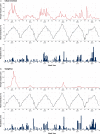Mosquito abundance in relation to extremely high temperatures in urban and rural areas of Incheon Metropolitan City, South Korea from 2015 to 2020: an observational study
- PMID: 34715902
- PMCID: PMC8555308
- DOI: 10.1186/s13071-021-05071-z
Mosquito abundance in relation to extremely high temperatures in urban and rural areas of Incheon Metropolitan City, South Korea from 2015 to 2020: an observational study
Abstract
Background: Despite concerns regarding increasingly frequent and intense heat waves due to global warming, there is still a lack of information on the effects of extremely high temperatures on the adult abundance of mosquito species that are known to transmit vector-borne diseases. This study aimed to evaluate the effects of extremely high temperatures on the abundance of mosquitoes by analyzing time series data for temperature and mosquito abundance in Incheon Metropolitan City (IMC), Republic of Korea, for the period from 2015 to 2020.
Methods: A generalized linear model with Poisson distribution and overdispersion was used to model the nonlinear association between temperature and mosquito count for the whole study area and for its constituent urban and rural regions. The association parameters were pooled using multivariate meta-regression. The temperature-mosquito abundance curve was estimated from the pooled estimates, and the ambient temperature at which mosquito populations reached maximum abundance (TMA) was estimated using a Monte Carlo simulation method. To quantify the effect of extremely high temperatures on mosquito abundance, we estimated the mosquito abundance ratio (AR) at the 99th temperature percentile (AR99th) against the TMA.
Results: Culex pipiens was the most common mosquito species (51.7%) in the urban region of the IMC, while mosquitoes of the genus Aedes (Ochlerotatus) were the most common in the rural region (47.8%). Mosquito abundance reached a maximum at 23.5 °C for Cx. pipiens and 26.4 °C for Aedes vexans. Exposure to extremely high temperatures reduced the abundance of Cx. pipiens mosquitoes {AR99th 0.34 [95% confidence interval (CI) 0.21-0.54]} to a greater extent than that of Anopheles spp. [AR99th 0.64 (95% CI 0.40-1.03)]. When stratified by region, Ae. vexans and Ochlerotatus koreicus mosquitoes showed higher TMA and a smaller reduction in abundance at extreme heat in urban Incheon than in Ganghwa, suggesting that urban mosquitoes can thrive at extremely high temperatures as they adapt to urban thermal environments.
Conclusions: We confirmed that the temperature-related abundance of the adult mosquitoes was species and location specific. Tailoring measures for mosquito prevention and control according to mosquito species and anticipated extreme temperature conditions would help to improve the effectiveness of mosquito-borne disease control programs.
Keywords: Aedes; Anopheles; Climate change; Culex; Mosquito population density; Mosquito-borne diseases.
© 2021. The Author(s).
Conflict of interest statement
The authors declare that they have no competing interests.
Figures





Similar articles
-
Three-year surveillance of culicine mosquitoes (Diptera: Culicidae) for flavivirus infections in Incheon Metropolitan City and Hwaseong-si of Gyeonggi-do Province, Republic of Korea.Acta Trop. 2020 Feb;202:105258. doi: 10.1016/j.actatropica.2019.105258. Epub 2019 Nov 13. Acta Trop. 2020. PMID: 31733189
-
Monitoring Culicine Mosquitoes (Diptera: Culicidae) as a Vector of Flavivirus in Incheon Metropolitan City and Hwaseong-Si, Gyeonggi-Do, Korea, during 2019.Korean J Parasitol. 2020 Oct;58(5):551-558. doi: 10.3347/kjp.2020.58.5.551. Epub 2020 Oct 22. Korean J Parasitol. 2020. PMID: 33202507 Free PMC article.
-
Comparison of climatic factors on mosquito abundance at US Army Garrison Humphreys, Republic of Korea.PLoS One. 2020 Oct 21;15(10):e0240363. doi: 10.1371/journal.pone.0240363. eCollection 2020. PLoS One. 2020. PMID: 33085720 Free PMC article.
-
Potential transmission of West Nile virus in the British Isles: an ecological review of candidate mosquito bridge vectors.Med Vet Entomol. 2005 Mar;19(1):2-21. doi: 10.1111/j.0269-283X.2005.00547.x. Med Vet Entomol. 2005. PMID: 15752172 Review.
-
An update on the mosquito fauna and mosquito-borne diseases distribution in Cameroon.Parasit Vectors. 2021 Oct 11;14(1):527. doi: 10.1186/s13071-021-04950-9. Parasit Vectors. 2021. PMID: 34635176 Free PMC article. Review.
Cited by
-
Wing geometric morphometrics and COI barcoding of Culex pipiens subgroup in the Republic of Korea.Sci Rep. 2024 Jan 9;14(1):878. doi: 10.1038/s41598-024-51159-8. Sci Rep. 2024. PMID: 38195670 Free PMC article.
-
Mapping the abundance of endemic mosquito-borne diseases vectors in southern Quebec.BMC Public Health. 2023 May 22;23(1):924. doi: 10.1186/s12889-023-15773-x. BMC Public Health. 2023. PMID: 37217931 Free PMC article.
-
Malaria prevalence, transmission potential and efficacy of artemisinin-based combination therapy in the Kenyan Central highlands: a zone previously characterized as malaria-free.Malar J. 2025 Jan 13;24(1):10. doi: 10.1186/s12936-024-05214-4. Malar J. 2025. PMID: 39800719 Free PMC article.
-
Evaluation of household coverage with long-lasting insecticidal nets in central Côte d'Ivoire.Malar J. 2025 Mar 29;24(1):104. doi: 10.1186/s12936-025-05335-4. Malar J. 2025. PMID: 40158121 Free PMC article.
-
Using mosquito and arbovirus data to computationally predict West Nile virus in unsampled areas of the Northeast United States.PNAS Nexus. 2025 Aug 19;4(8):pgaf227. doi: 10.1093/pnasnexus/pgaf227. eCollection 2025 Aug. PNAS Nexus. 2025. PMID: 40838020 Free PMC article.
References
Publication types
MeSH terms
Grants and funding
LinkOut - more resources
Full Text Sources
Medical
Research Materials
Miscellaneous

